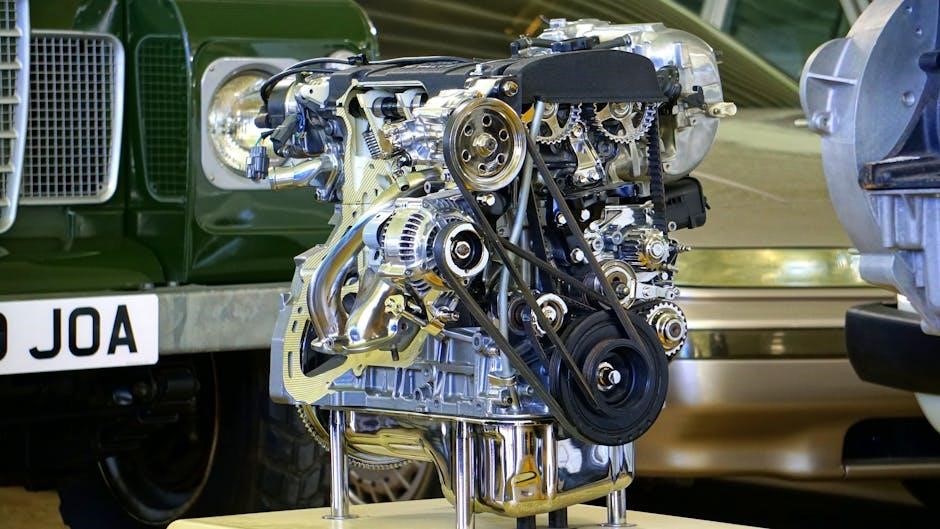murray drive belt diagram manual
A Murray drive belt diagram manual is an essential tool for lawn tractor owners. It provides detailed visual guides and instructions for installing‚ maintaining‚ and troubleshooting the drive belt system. With labeled diagrams and clear explanations‚ the manual helps users understand how components like pulleys‚ tensioners‚ and belts work together. This resource is crucial for ensuring proper function and extending the lifespan of your Murray mower. Referencing the manual is the first step in any repair or maintenance task.

Importance of the Murray Drive Belt Diagram
The Murray drive belt diagram is a critical resource for anyone working on their Murray lawn tractor or riding mower. It provides a visual representation of the drive system‚ making it easier to understand how the belt interacts with other components like pulleys and tensioners. This diagram is essential for proper maintenance‚ troubleshooting‚ and replacement of the drive belt. Without it‚ identifying the correct routing or tension specifications would be challenging‚ potentially leading to improper installation and machine damage.
The diagram’s importance extends to DIY enthusiasts and professional technicians alike. It ensures that repairs are done correctly‚ reducing the risk of accidents caused by faulty belt installations. Additionally‚ the diagram helps users identify worn or damaged parts early‚ preventing costly breakdowns. By following the manual’s instructions‚ users can maintain their mower’s performance and extend its lifespan.
For those unfamiliar with mechanical systems‚ the Murray drive belt diagram simplifies the process of diagnosing issues. It highlights the relationship between the belt and other critical components‚ enabling users to pinpoint problems quickly. This resource is also invaluable for ordering the correct replacement parts‚ as it provides clear labels and part numbers. Overall‚ the diagram is a must-have for anyone looking to keep their Murray mower in optimal condition.
Moreover‚ the Murray drive belt diagram manual serves as a safety guide. Proper belt installation and tensioning are crucial to prevent accidents during operation. The diagram ensures that users follow manufacturer-recommended procedures‚ minimizing risks associated with improper adjustments. By adhering to the instructions‚ users can ensure their mower operates safely and efficiently.

How to Find the Correct Murray Drive Belt Manual
Locating the correct Murray drive belt manual is a straightforward process if you follow the right steps. First‚ identify your Murray product’s model number‚ which is typically found on the back of the mower or in the owner’s manual. This number is essential for finding the exact manual for your specific model.
- Visit the Murray Official Website: The Murray website offers a search tool where you can enter your model number to find the corresponding operator’s manual. This manual often includes detailed diagrams and instructions for drive belt installation and maintenance.
- Use Online Manuals Platforms: Websites like ManualsLib or Outdoor Distributors provide access to various Murray manuals. Search for your model number on these platforms to download the manual or view it online.
- Check with Authorized Dealers: Murray authorized dealers often have access to manuals and parts diagrams. Contacting them can be a reliable way to obtain the correct manual for your mower.
- Consult Customer Support: Reach out to Murray’s customer support team directly. Provide your model number‚ and they can guide you to the appropriate manual or provide a direct link to download it.
- Search for Parts Diagrams: If the manual isn’t immediately available‚ look for exploded-view diagrams specific to your model. These diagrams detail the drive belt system and can be found on Murray’s website or through parts suppliers.
Ensure the manual you use matches your mower’s exact model‚ as drive belt configurations can vary. Using the wrong manual may lead to incorrect belt routing or tensioning‚ which can damage the mower. By following these steps‚ you can quickly and easily find the correct Murray drive belt manual to assist with repairs‚ maintenance‚ or belt replacement.
Additionally‚ many online forums and communities dedicated to Murray products offer shared manuals and advice from experienced users. These resources can be invaluable if you’re unable to find the manual through official channels. Always verify the source of the manual to ensure accuracy and avoid using unofficial or incorrect documentation.

Key Components of the Murray Drive Belt Diagram
The Murray drive belt diagram highlights essential components for proper belt installation and function. These include the drive belt‚ which powers the mower’s movement‚ and the pulleys that guide it. The tensioner assembly ensures the belt remains taut‚ and retaining brackets secure the belt in place. These parts work together to maintain efficient operation and prevent wear. Understanding these components is crucial for accurate belt routing and troubleshooting.
4.1. Drive Belt
The drive belt in a Murray lawn mower is a critical component responsible for transmitting power from the engine to various parts of the mower‚ such as the cutting blades and wheels. Typically made of durable rubber reinforced with fibers for strength‚ the drive belt is designed to withstand the rigors of continuous operation. It usually features a serpentine design with grooves that fit onto pulleys‚ ensuring a secure grip and preventing slippage.
In different Murray mower models‚ the specific type of drive belt may vary. Larger‚ more powerful mowers often require heavier-duty belts to handle increased loads‚ while smaller mowers may use simpler‚ more straightforward belts. Proper maintenance involves regular inspection for signs of wear‚ such as cracks or fraying‚ which indicate the need for replacement. Inspecting the belt at the start of each mowing season or with every oil change is a good practice to prevent unexpected breakdowns.
The drive belt’s interaction with other components‚ like pulleys and the tensioner assembly‚ is essential for optimal performance. A loose belt can lead to slippage‚ reducing efficiency and potentially causing the mower to stop moving. Ensuring the correct tension is crucial‚ and the tensioner assembly plays a key role in maintaining this balance. Replacing the drive belt requires careful installation‚ often guided by a diagram in the manual that illustrates the correct routing around pulleys to ensure smooth operation.
Signs of a failing drive belt may include unusual noises‚ decreased power‚ or erratic movement. Identifying these symptoms early can help prevent more severe damage. Replacing the belt typically requires basic tools like wrenches and screwdrivers‚ though it’s advisable to consult the manual for specific instructions. Availability and cost of replacement belts vary‚ with many being readily available at hardware stores or through Murray dealers. Understanding and maintaining the drive belt is fundamental to keeping the mower operational and extending its lifespan.
4.2. Pulleys
Pulleys are essential components in the Murray drive belt system‚ serving as the points around which the drive belt rotates. These pulleys are typically made of durable materials‚ such as metal or heavy-duty plastic‚ and are designed to withstand the constant wear and tear of lawn mowing operations. Their smooth surfaces ensure efficient power transmission from the engine to other parts of the mower.
The Murray drive belt diagram manual provides a detailed illustration of the pulleys‚ highlighting their specific locations and configurations. These diagrams are crucial for understanding how the drive belt interacts with each pulley‚ ensuring proper installation and maintenance. Pulleys are typically categorized into two types: idler pulleys and tensioner pulleys. Idler pulleys are fixed in place and provide a surface for the drive belt to wrap around‚ while tensioner pulleys are adjustable and play a key role in maintaining the correct belt tension.
Proper alignment and tension of the pulleys are vital for the smooth operation of the drive belt. Misaligned pulleys can cause uneven wear on the belt‚ leading to premature failure. The manual often includes step-by-step instructions for adjusting pulleys to achieve the optimal setup. In some Murray models‚ the tensioner pulley is equipped with a spring or other mechanism to automatically maintain the correct tension‚ reducing the need for manual adjustments.
Regular inspection of the pulleys is recommended to ensure they remain in good condition. Signs of wear‚ such as rust‚ dents‚ or excessive play‚ should be addressed promptly. Replacing worn or damaged pulleys is a straightforward process when guided by the manual’s exploded diagrams and parts lists. Proper maintenance of the pulleys not only extends the lifespan of the drive belt but also ensures the overall performance and efficiency of the mower.
4.3. Tensioner Assembly

The tensioner assembly is a critical component of the Murray drive belt system‚ responsible for maintaining the correct tension of the drive belt. Proper tension ensures efficient power transmission‚ prevents belt slippage‚ and reduces wear on both the belt and pulleys. The tensioner assembly typically consists of a tensioner pulley‚ a spring or similar mechanism‚ and mounting brackets. These components work together to apply consistent pressure on the drive belt.
According to the Murray drive belt diagram manual‚ the tensioner assembly is usually located near the engine or on the mower deck‚ depending on the specific model. The manual provides detailed exploded diagrams that illustrate the assembly’s structure‚ making it easier to identify and access each part. This visual guide is particularly useful for users who need to perform adjustments or replacements.
Adjusting the tensioner assembly is a straightforward process when following the manual’s instructions. In most cases‚ the tensioner can be adjusted by loosening the mounting bolts and moving the assembly to the desired position. The manual often includes specifications for the correct tension‚ ensuring the belt is neither too tight nor too loose. Over-tightening can lead to premature wear on the belt and pulleys‚ while under-tightening may result in slippage and reduced performance.
Regular inspection of the tensioner assembly is essential to maintain optimal drive belt performance. Signs of wear‚ such as a weakened spring or worn-out pulley‚ should be addressed promptly. The manual provides part numbers and diagrams to help users locate and replace any damaged components. In some models‚ the tensioner assembly may also include a locking mechanism to secure the belt in place‚ further enhancing stability.
